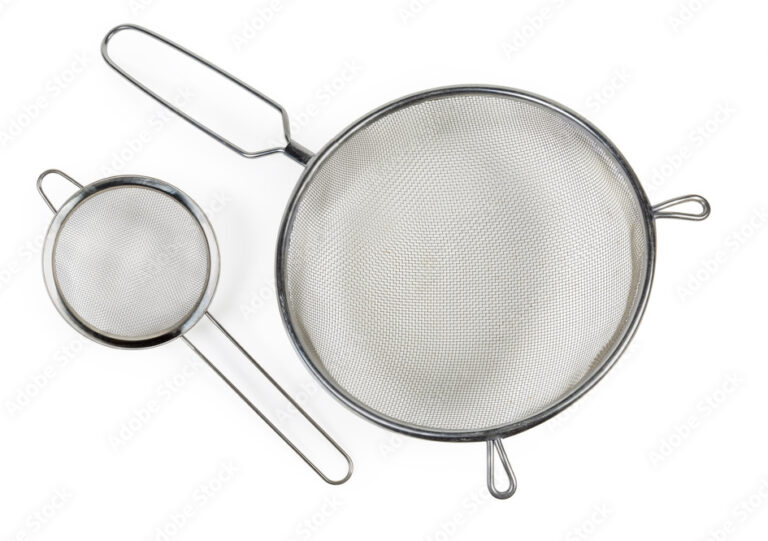Looking to choose between a sieve vs. strainer for your kitchen needs? This comprehensive article will give you 7 crucial pointers to help you decide wisely. Discover the differences, benefits, and uses of sieves and strainers to become a kitchen hero!
Table of Contents
ToggleIntroduction
In the culinary world, even the smallest tools can make a significant impact on the outcome of your dishes. Two such tools, the Sieve vs. Strainer, often spark confusion due to their similar appearances and functions. Don’t fret, though! This comprehensive guide will walk you through the essential differences between Sieves and Strainers, helping you make the right choice for your kitchen endeavors.

Sieve vs. Strainer: Exploring the Key Differences
Understanding the Basics
Before delving into the differences of Sieve vs. Strainer, let’s clarify the basic definitions of these kitchen essentials.
Sieve: A sieve is a utensil comprised of a fine mesh or perforated surface used to separate fine particles from liquids. It’s commonly employed to sift dry ingredients, like flour or powdered sugar, and strain liquids, such as sauces and stocks.
Strainer: A strainer, on the other hand, also features a mesh or perforated surface, but its purpose primarily involves separating solid pieces from liquids. Strainers are perfect for draining pasta, washing fruits and vegetables, and straining tea or cocktails.
Differentiating Factors: Sieve vs. Strainer
Mesh Density Matters
Both sieve vs. strainer feature mesh, but their densities differ. A sieve usually boasts finer mesh to capture finer particles, making it ideal for tasks like sifting flour. Strainers have a coarser mesh, allowing liquids to pass through while holding back larger solids.
Function Dictates Design
The intended function drives the design of these tools. Sieves are typically deeper with a rounded shape, accommodating larger volumes of ingredients for sifting and straining. Strainers have a shallower shape, optimized for draining liquids from solids.

Application Arsenal
Sieve vs. Strainer: Sieves are your go-to for baking tasks that require precise measurements and smooth textures. Strainers shine when you need to separate cooked pasta from water, rinse vegetables, or strain impurities from sauces.
Multi-Purpose Magic
While sieves are mainly used for sifting and straining, strainers excel in diverse tasks. Their broader functionality extends to rinsing grains, draining canned goods, and even sifting larger particles.
Liquid Handling
When we talk about Sieve vs. Strainer, strainers take the lead when it comes to efficiently draining liquids, thanks to their larger perforations. Sieves are better suited for delicate tasks where you need to sift dry ingredients without crushing them.
Size and Portability
Sieves are usually larger due to their deeper design, making storage slightly more challenging. Strainers are compact and easy to store, making them a convenient choice for smaller kitchens.
7 Tips to Help You Decide: Sieve or Strainer?
Consider Your Cooking Style
Are you an avid baker or a pasta enthusiast? Determine your primary cooking needs to choose between sieve vs. strainer with the precision of a sieve and the versatility of a strainer.
Assess Frequency of Use
Reflect on how often you’ll use the tool. If you frequently bake or cook dishes requiring sifting, a sieve might be essential. For daily cooking and draining tasks, a strainer might be more practical.

Available Storage Space
Take stock of your kitchen’s storage capacity. If space is limited, a compact strainer could be your best bet.
Think about Ingredients
Consider the types of ingredients you handle most. If your recipes often involve finely sifted dry ingredients, a sieve is indispensable. Strainers accommodate various ingredients and liquids.
Versatility vs. Specialization
Strainers offer versatility, making them a valuable addition to any kitchen. If your needs lean towards specific tasks, a sieve might be more appropriate.
Ergonomics and Handling
Hold both tools in your hand and assess their comfort. Choose the one that feels easier to manage during your cooking adventures.
Budget Considerations
Finally, factor in your budget. Sieves and strainers come in a range of price points. Decide what you’re comfortable investing in.

Conclusion
In the exciting realm of cooking, choosing between a sieve vs. strainer need not be a daunting task. Armed with these 7 essential tips, you’re equipped to make a decision that aligns with your culinary preferences and kitchen needs. Whether you opt for the precision of a sieve or the versatility of a strainer, your culinary creations are bound to reach new heights!
FAQs
Q: Can I use a strainer for sifting dry ingredients?
A: While a strainer can work for sifting larger particles, using a sieve will yield smoother results for delicate tasks like baking.
Q: What’s the main advantage of using a sieve?
A: Sieves are designed for precise sifting, ensuring uniform texture and consistent measurements in your baked goods.
Q: Are there any creative uses for a strainer?
A: Absolutely! Beyond its traditional functions, a strainer can be employed as an impromptu citrus juicer or even for dusting desserts with powdered sugar.
Q: Can I strain pasta with a sieve?
A: Yes, you can use a sieve to strain pasta. However, a strainer’s larger perforations might make the process faster and more efficient.
Q: How do I clean these tools?
A: Both sieves and strainers should be rinsed immediately after use to prevent food particles from drying and sticking. To get rid of tough parts, use a brush.
Q: Which tool is better for making cocktails?
A: A strainer is your best friend in the cocktail-making world. It effectively strains ice and other solid ingredients, ensuring a smooth sip.
